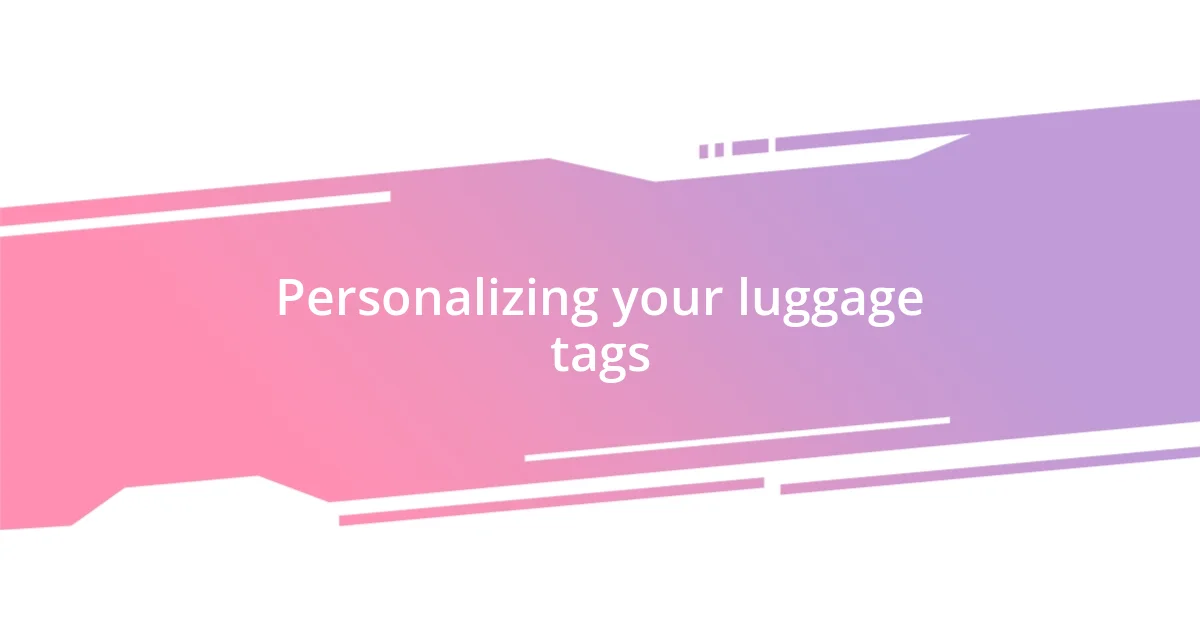Key takeaways:
- Sewing luggage tags allows for personal expression through unique fabric choices and embellishments, making travel gear reflective of one’s personality.
- Handcrafted tags offer benefits like durability, distinctiveness, and cost-efficiency, enhancing the overall travel experience.
- Common sewing challenges, such as thread tension and fabric slipping, can be managed with the right tools and techniques, improving the sewing process.

Introduction to sewing luggage tags
Sewing luggage tags is a delightful and practical way to add a personal touch to your travel gear. I remember the first time I stitched one—I was excited about the prospect of making something that was not only unique but also functional. Have you ever thought about how plain store-bought luggage tags just don’t capture our personalities?
What I find especially rewarding is the opportunity to choose fabrics and designs that truly reflect who I am. I often think back to a vibrant tag I created with a floral print, which not only made my suitcase stand out in the crowd but also sparked conversations with fellow travelers. It’s amazing how a little creativity can turn something ordinary into a conversation starter, isn’t it?
Moreover, sewing a luggage tag can feel like a mini adventure before your travels even begin. As I carefully selected the materials, I recalled previous trips and the memories associated with them. It’s funny how a simple tag can evoke such warm feelings and anticipation for the journeys ahead!

Benefits of making luggage tags
Creating your own luggage tags brings a host of benefits that go beyond mere functionality. I’ve discovered that handcrafted tags not only allow for personal expression but also enhance the overall travel experience. The sense of accomplishment I felt after finishing my first tag was invigorating; it felt like I was gearing up for my journey before it even started.
Here are some benefits of making luggage tags:
- Personalization: You can choose the colors and patterns that tell your story.
- Durability: Sewing using quality materials can create a sturdy tag that outlasts store-bought versions.
- Distinctiveness: Your tags truly stand out, making it easy to spot your luggage among a sea of similar bags.
- Cost-efficiency: It saves money in the long run compared to purchasing new tags for each trip.
- Skill-building: Each project hones your sewing skills and boosts your confidence for more complex projects.
I still remember traveling to a festival with friends, where my handmade luggage tag caught the eye of a fellow festival-goer. We struck up a conversation about our favorite travel experiences, leading to a newfound friendship! Such moments are what makes sewing luggage tags worthwhile.

Materials needed for luggage tags
When it comes to materials for sewing luggage tags, there are a few essentials you’ll never want to skip. I typically start with a sturdy fabric, like canvas or cotton, as these offer both durability and flexibility. I remember choosing a vibrant cotton fabric with a quirky pattern for my last tag, and it not only held up well but also brought me joy every time I handled my suitcase. A good choice in fabric can truly set the tone for your project.
You’ll also need a few tools to help you along the way. Essential items include scissors, a sewing machine (or needle and thread for hand-sewing), and a rotary cutter for precise edges. I learned this the hard way after attempting my first tag with dull scissors—it turned into quite the challenge! Having the right tools can make your sewing experience much more enjoyable and efficient, ensuring your tags turn out just how you envisioned them.
Don’t forget the finishing touches; these details can really make your tag shine. I often use interfacing to add structure, while a decorative button or stitch can elevate the overall aesthetic. There’s something satisfying about adding that personal flair. What about you? Have you considered what little touches you’d like to include in your own luggage tag creations?
| Material | Description |
|---|---|
| Fabric | Durable fabric such as canvas or cotton for the main body |
| Interfacing | Padded backing to provide stiffness and durability |
| Sewing Tools | Scissors, sewing machine, and needles for assembly |
| Decorative Items | Buttons, ribbons, or embellishments for personalization |

Step by step sewing process
Once I’ve gathered all my materials, I dive into the sewing process with enthusiasm. I start by cutting the fabric into the desired shape, making sure to mark any slots for the name tag. I often find myself smiling as I visualize how each piece will come together—it’s almost like piecing together a little puzzle. Have you ever felt that thrill of seeing a project take shape right before your eyes?
Next, I assemble the layers, placing the interfacing between the fabric pieces for added strength. As I pin everything down, I can’t help but think back to my first attempt at a luggage tag, where I forgot this crucial step. It turned into a floppy mess! Learning from those early mistakes has truly made my sewing journey much smoother and rewarding.
Finally, I run everything through the sewing machine, relishing the rhythmic hum as my tag comes to life. Once I finish stitching, I can’t resist giving it a final touch of personality—like a hand-stitched edge or a quirky button. Moments like these remind me that sewing isn’t just about creating; it’s about expressing who I am. How do you add your own unique touch to projects?

Personalizing your luggage tags
Personalizing your luggage tags is where the real fun begins! For me, it’s all about injecting a piece of my personality into the design. One of my favorite touches was using fabric scraps from other projects—those little remnants bring back memories every time I catch a glimpse of my tag during travel. Have you ever considered what memories your fabric choices could tell?
Another way I make my tags uniquely mine is by adding quirky embellishments. A few years ago, I discovered some colorful buttons in various shapes, and I couldn’t resist sewing them onto my tags. Each button holds a story, whether it’s a playful dinosaur or a bright flower, and I find that they spark conversations with fellow travelers. Have you thought about what little details could make your tags stand out at the baggage claim?
I also love adding a personal flair to the information section. Instead of just my name, I sometimes include fun facts about myself or a favorite quote that resonates with my travel spirit. I remember one trip where I’d sewn “Adventure Awaits” right beneath my name—it became a source of inspiration every time I reached for my suitcase. Isn’t it fascinating how a simple luggage tag can reflect who we are?

Troubleshooting common sewing issues
When sewing, it’s almost inevitable to stumble upon some common issues that can leave you feeling frustrated. I remember my first experience with thread tension. I was excitedly stitching away when I noticed the fabric was puckering—a telltale sign my tension was off. It’s so easy to overlook, but I learned that adjusting the tension dial can make all the difference. Have you ever faced that moment of panic when your project doesn’t look quite right?
Another frequent hiccup is dealing with fabric slipping while sewing. I recall a particularly slippery vinyl that had other plans. My machine would stitch unevenly, creating a jagged edge instead of a smooth line. That’s when I discovered the beauty of using clips instead of pins to hold slippery materials in place. It’s a game changer! Have you tried switching up your tools to tackle those tricky fabrics?
Let’s not forget about the dreaded thread breaking mid-stitch. I can’t count how many times that has derailed my sewing momentum! I found that choosing the right needle for the fabric type is crucial. For example, a universal needle works well for most woven fabrics but switch to a ballpoint needle for knits. When I finally made that connection, my sewing became so much more enjoyable. Don’t you agree that knowing your tools can elevate your crafting experience?














